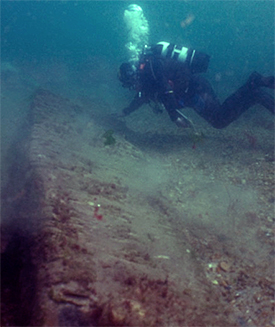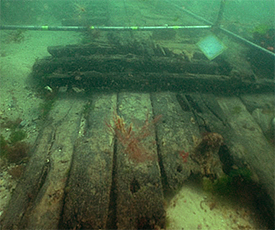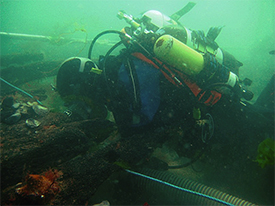
Good Visibility Reveals More Details
8 July 2010
By Danni Seliger

A diver examines the rudder (photograph courtesy of Bournemouth University).
A month into the project the Swash Channel Wreck excavation is now well under way despite a few setbacks due to poor weather conditions. Luckily we have also had good diving days with 15m visibility which is much better than we have seen on the site for years, giving it an almost Mediterranean feel, and providing us for the first time with a visual impression of the site as a whole. Almost the entire bow structure has been cleared off and lies exposed on the seabed revealing constructional details as well as artefacts that haven’t been seen before.
One of the more interesting features to be brought to the surface was a section of special sacrificial sheathing, a composite material made up of closely spaced nails, pine wood and a matting made of animal hair and tar, that seems to have been nailed onto the outside of the entire hull beneath the waterline. The sheathing was meant as a protective measure against the aggressive marine wood borers that ships would encounter when sailing to tropical regions with warm water.

A section of forecastle (photograph courtesy of Bournemouth University).
Marine borers (popularly known as ship worm) are present in almost any coastal region around the world where they attach themselves to any wood available into which they bore holes to create well-protected living spaces. In fact such borers are one of the main problems for the present day shipwreck as they massively speed up the wood degradation already caused by abrasion and bacteria. In the early 17th century however, they expended time and expense to fit the sheathing only on ships bound for tropical regions where wood borers were much more aggressive and where regular careening and repair were less likely to take place.
The sheathing is, in other words, in itself a prime indicator of the function of the ship: to make oceanic voyages into tropical regions. Furthermore masses of rope and dead-eyes have been found concreted to the side of the ship. At this point in time it seems likely from its position and from the types of rope found that it might have formed the part of the standing rigging as it was attached to the ship’s side by a number of chain plates. In time and with further analysis it is hoped that this will reveal further details of the general rigging of the ship. Other finds include masses of concretions, pottery and a couple of clay pipes. The latter interestingly do not seem to be part of the shipwreck as they are of a later date and it is probable that they are discarded pipes thrown overboard by local fishermen.

Danni Seliger on the dredge (photograph courtesy of Bournemouth University).
The excavation has further revealed what seems to be surviving timbers running almost complete from the top of the bowcastle to the keel. As yet the keel itself has not been found and interpretations on the construction of the ship are still very difficult to make as the ceiling planking from the inside of the ship is obscuring the underlying hull planking.
Return to MUA Project Journals home page.

